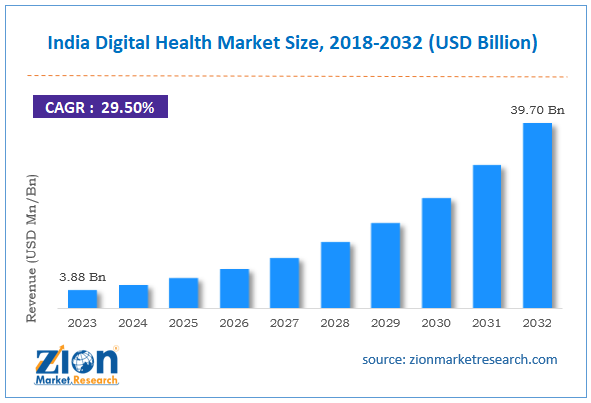Market Overview
The digital health market in India is witnessing significant growth driven by the increasing adoption of digital technologies in healthcare. Digital health encompasses a wide range of services and solutions, including telemedicine, health information systems, mobile health applications, wearable devices, and AI-driven healthcare solutions. The Indian government’s initiatives and policies aimed at enhancing healthcare access and quality through digital means are further propelling the market.
Market Size and Growth
As of 2023, the india digital health market size was valued at approximately USD 3.88 billion. It is projected to grow at a compound annual growth rate (CAGR) of around 29.5% from 2024 to 2032, reaching an estimated value of USD 39.70 billion by 2032.

Key factors driving this growth include:
- Government Initiatives: Programs such as Ayushman Bharat Digital Mission (ABDM) aiming to create a robust digital health infrastructure and improve access to healthcare services.
- Technological Advancements: Rapid advancements in telemedicine, mobile health applications, and AI-driven diagnostic tools enhancing healthcare delivery and patient outcomes.
- Rising Healthcare Costs: Increasing healthcare costs driving the demand for cost-effective digital health solutions and services.
- Consumer Awareness: Growing awareness among consumers about the benefits of digital health solutions, leading to higher adoption rates.
Market Segmentation
By Solution Type
- Telemedicine: Enabling remote consultations, diagnosis, and treatment through digital platforms. It has seen a surge in adoption, especially during the COVID-19 pandemic.
- Mobile Health (mHealth) Applications: Health-related mobile apps for monitoring, diagnostics, fitness tracking, and disease management.
- Electronic Health Records (EHR): Digital systems for storing and managing patient health information, improving accessibility and efficiency.
- Wearable Devices: Devices such as fitness trackers, smartwatches, and health monitors that track various health metrics and provide real-time data.
- Health Information Systems: Comprehensive systems for managing hospital operations, patient information, and clinical workflows.
- AI and Big Data Analytics: AI-driven tools and big data analytics for predictive diagnostics, personalized treatment plans, and operational efficiency.
By End User
- Healthcare Providers: Hospitals, clinics, and healthcare professionals adopting digital health solutions to improve patient care and operational efficiency.
- Patients: Individuals using telemedicine, mHealth apps, and wearable devices for managing their health and wellness.
- Pharmaceutical Companies: Utilizing digital health technologies for drug development, clinical trials, and patient monitoring.
- Government and Public Health Organizations: Implementing digital health solutions to enhance public health programs and initiatives.
Regional Insights
- Urban Areas: Higher adoption of digital health technologies due to better infrastructure, higher disposable incomes, and greater awareness.
- Rural Areas: Growing focus on extending digital health services to rural and remote areas to improve healthcare access and outcomes, supported by government initiatives.
Key Trends and Innovations
- Integration of AI and Machine Learning: Enhanced diagnostic accuracy, predictive analytics, and personalized treatment plans through AI and machine learning technologies.
- Expansion of Telehealth Services: Increasing use of telehealth services for consultations, follow-ups, and chronic disease management, driven by convenience and cost-effectiveness.
- Growth of Wearable Health Devices: Rising popularity of wearable devices for continuous health monitoring and proactive health management.
- Blockchain in Healthcare: Implementation of blockchain technology for secure, transparent, and efficient management of health records and data sharing.
- Collaborations and Partnerships: Increased collaborations between healthcare providers, tech companies, and government bodies to develop and implement digital health solutions.
Challenges
- Data Privacy and Security: Ensuring the privacy and security of sensitive health data amidst increasing cyber threats and regulatory requirements.
- Infrastructure and Connectivity: Addressing challenges related to digital infrastructure and internet connectivity, particularly in rural and remote areas.
- Regulatory and Compliance Issues: Navigating the complex regulatory landscape and ensuring compliance with evolving health data regulations and standards.
- Consumer Trust and Adoption: Building trust and encouraging adoption of digital health solutions among consumers and healthcare providers.
Competitive Landscape
The Indian digital health market is highly competitive, with numerous startups and established companies vying for market share. Key players include:
- Practo: A leading digital healthcare platform offering telemedicine, online appointment booking, and health records management.
- 1mg: An online pharmacy and healthcare platform providing teleconsultations, diagnostic services, and health information.
- Cure.fit: A health and fitness company offering digital fitness classes, health tracking, and wellness services.
- PharmEasy: An online pharmacy and healthcare app providing medicine delivery, lab tests, and teleconsultations.
- Niramai: A healthcare startup utilizing AI for early-stage breast cancer detection through thermal imaging.
Future Outlook
The digital health market in India is poised for substantial growth, driven by technological advancements, government support, and increasing consumer awareness. Innovations in AI, telemedicine, wearable devices, and health information systems will continue to shape the market landscape. Efforts to address challenges related to data security, infrastructure, and regulatory compliance will be crucial for sustained growth and widespread adoption.
For specific forecasts and detailed insights into the India digital health market up to 2032, consulting specialized industry reports or market research firms focusing on healthcare technology and digital health would provide the most comprehensive and up-to-date information.
Read Also:
https://www.linkedin.com/pulse/top-beer-companies-world-comprehensive-overview-2024-zmr-blog-vt8zf?



